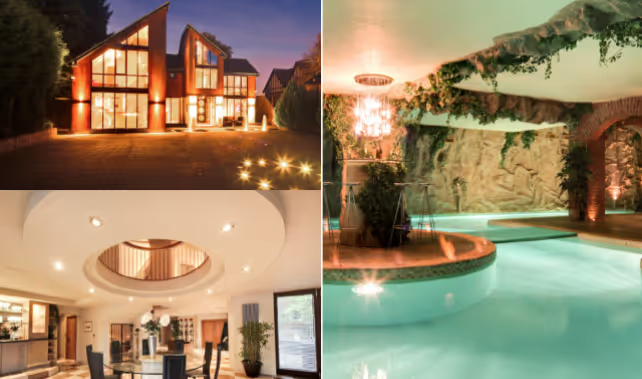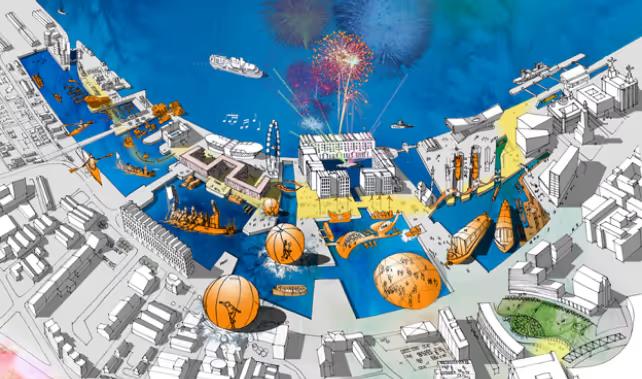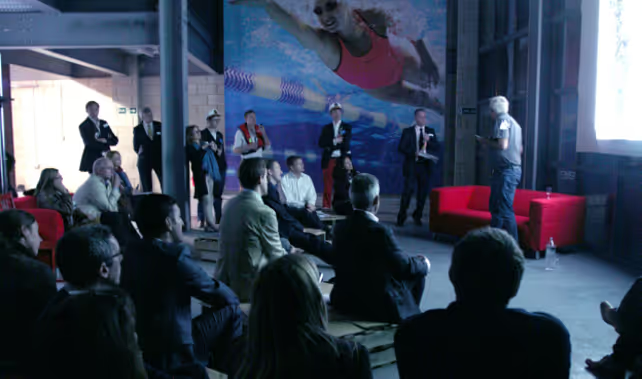

Concentrating on creating tailored homes around the Midlands area, Baca Architects and the Guy Phoenix Group will unite to combine their considerable expertise in creating multi-million pound, award-winning homes. By harnessing the creative talents and experience of both companies, the latest in digital technology and environmentally considerate materials can be utilised: the opportunity to create ever more refined bespoke homes is widened.
With the two companies sharing a strong synergy and a reputation for delivering exceptional and high-quality designs, the Midlands can look forward to the collaboration producing some of the most beautiful homes in the country, right on its doorstep.
BACA architects are pleased to announce a new partnership with the prestigious, Midlands-based, Guy Phoenix Group. In the recent International Property Awards, Guy Phoenix was the only company to be recognised in every award category and the company enjoys a reputation for delivering exceptional and beautiful homes.
Read More
Tonight 19:00 BBC 1
Kevin McCloud will be promoting Grand Designs Live on the BBC One show tonight. BACA’s Serenity will feature as exclusive images are revealed.

The house resides safely above the 1 in 100 flood level supported by a network of micro piles. The dwelling is located in a village that suffers flooding from the Thames and its tributaries. The elevated design not only offers flood safe accommodation but provides added flood storage with the aim to reduce flood damage to neighbouring property.
Last week BACA’s Brook Street project was published in Building Design Magazine’s First Look segment.
Read More
Tune in to BBC 2 at 10:00 on Wednesday 13th March to watch the report.
The Culture Show are set to feature Baca in a segment on water based Architecture.
Read More
An exciting plan to maximise the potential of Liverpool’s 250-year old South Docks is expected to be endorsed by Liverpool City Council when a new waterspace strategy goes before its committee on 19 November.
Working with key stakeholders, the Canal & River Trust appointed international architects BACA to produce an innovative and creative waterspace strategy to unlock the potential of the historic docks.
The strategy has been developed as a guide to inform future development of the waterspace within the South Docks.It seeks to transform the docks into a vibrant cultural centre extending from Canning Dock in the north to Brunswick Dock in the south.
Making use of its unique World Heritage setting, the strategy identifies potential for three distinct character zones within the docks:
The Culture Zone – Albert and Canning Dockswould be the centre of futureboat festivals, cultural celebrations and even a floating sculpture park Mixed Use Zone – Salthouse Dock could be a floating event space withenhanced public realm and improved interaction between the land and water.
A Mixed-Use Zone – Dukes Dock and Wapping Basin could be home to a floating waterpark with kiosks and pavilions at the quayside to encourage year round activity
Leisure & Aquatic Zone – New opening bridges in Wapping, Queens, Brunswick and Coburg Docks would improve and enhance the existing marina and expand the number of moorings for a wide variety of boats.
Julie Sharman, head of enterprise, Canal & River Trust said: “BACA has worked closely with our key stakeholders during the last 18 months to develop an innovative and sustainable strategy to guide future developments within this wonderful historic docks system. There is so much potential and this strategy really pinpoints what we could see developed in the docks in the future.”
Richard Coutts, project director for BACA architects said: “The waterspace strategy is a comprehensive and long-term plan to breathe new life into the once great Liverpool Docks. Unlike other water strategies, the Liverpool South Docks is conceived as a masterplan on water. It considers all aspects of design such as, ‘water use’, floating and fixed infrastructure, ‘water plots’, phasing and integration with land based development. Realisation of the plan will transform this part of Liverpool and provide a stable long-term structure for investment. Such an approach is readily transferrable to any dock network globally and can be used to stimulate opportunity and investment.’
Liverpool City Council’s Cabinet Member for Regeneration, Councillor Malcolm Kennedy, said: “These are exciting proposals, which will play an important part in the future development of the south docks. The city’s waterfront is one of our greatest assets and we want to develop it to its full potential. This strategy lays out the blueprint for how, working together, we can achieve that.”
The Canal & River Trust will continue to work with Liverpool City Council and other partners to develop the dock system into a world class visitor attraction.
Liverpool’s 35 hectare waterspace is part of the UNESCO world heritage site and is surrounded by some of the largest collections of Grade I listed buildings in the UK.
Relevant articles:

Last night, BACA architects hosted an informative and entertaining evening theme ‘Aquatecture’ in the new White Post Quay building on the Hertford Canal in East London.
Part of London’s Open House, Green Sky Thinking, the symposium examined how the role of water in cities is changing and the role it can play in shaping our built environment in the future, in response to the need, threat, benefit and pleasure that can be found from water.
Some very interesting themes were raised and discussed in the wonderful new foyer space fronting on to the canal. The building itself is an example of Baca’s integrated design approach, in which the foyer space, a covered public private space fronting the canal, creates activity and animation of the waterfront as well as providing a safe haven for occupants of the surrounding buildings and users of the canal towpath.
A ‘who wants to be a millionaire’ style quiz tested the knowledge of some of the leading experts in the water and design industry. Following a tiebreaker question the bottle of champagne went to Samantha Heath.
Amongst several suggestions, Kevin Reid from the GLA, called for new development to make better connections with London’s waterways both the River Thames and it’s many (often forgotten) tributaries, such as the River Moselle in North London. Kevin also cautioned that urban flood water is rarely blue, therefore efforts to make space for water must bare in mind the contaminants and clean up.
Samantha Heath, from the London Sustainability Exchange, highlighted the problems of water both in-terms of localised flooding, where it is often unexpected, and in-terms of drought.
Marnix de Vriend from Aquae, Netherlands, called for modesty and grace in connecting with ‘kissing the water’; and provided thought provoking stories of African communities that celebrate the arrival of annual flood waters, where children are excited to visit their grandparents by boat.
Hosts, Robert Barker and Richard Coutts presented a number of projects including the LifE approach, Amphibious Construction, Climate Adaptive Neighbourhoods, and their latest masterplan in Paris examining waterspace planning through a rage of scale and applications. Baca architects made many suggestions to use London’s waterspace more creatively, drawing upon examples from their recently completed waterspace plan for Liverpool South Docks, Hamburg and Austria. They also suggested the opportunity that water brings to make better planning, transport links, amenity and place making. BACA proposed two challenging proposals – ‘The Three generation rule‘ and ‘The Innovation License‘
The first of which, captures the spirit of sustainability, in advocating a three generation rule. Three generations from grandmother, to mother and to daughter could conceivably span over 150 years. If the planning process considered a 150 to 200 year future (as explored through the award winning LifE project) the plans proposed today may need to change, to leave the opportunity for the 2nd and 3rd generations to thrive in the environment in which we leave them. If we do not take this view then we are at risk of falling foul of the Boiling Frog analogy, in which we may willingly participate in climate change overwhelming our civilisation.
The second, The Innovation License, would be to grant licenses for innovative buildings and designs to be carried out on pre-selected sites on floodplains, in inner city urban flood risk sites and on the waterspaces. These licenses would need to meet a series of overarching environmental, hydrological and, importantly, design aspirations to be granted one of a limited number of annual licenses. Failure to meet these requirements would see the license revoked. Riding the Legacy wave of the Olympics, these initial licenses would be an incentive for public and private companies to innovate and compete to make better design solutions that could stimulate wider regeneration in London, establish a technological creativity hub in the UK and provide the opportunity for UK businesses to demonstrate innovation internationally that could be exported to the rest of the world. Should these schemes succeed in achieving their performance criteria then these pilots would become future exemplars, incrementally raising the bar for sustainability and filtering down into policy reforms with each new year’s license.
To put this into context BACA made a comparison of scales between the Royal Victoria Dock and London landmarks, demonstrating that it could accommodate two and a half Westfield shopping centres, 20 Buckingham Palaces and 500 White Post Quay buildings! The Innovation License could act as a precursor to the regeneration of many of the under-utilised docks and marinas that are often no more than glorified reflecting pools to the tall buildings that over shadow them. If only 5% of the enclosed, waterspaces in London were considered for floating development this could provide an additional 2000 homes or businesses in the capital. Perhaps these new floating businesses might also capture the spirit of creativity of the buildings in which they inhabit.